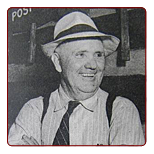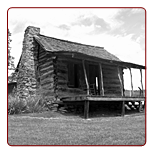About Us / Our History
 Beginning: 1925
Beginning: 1925In February 1925, Reverend Hiram Frakes observed a murder hearing in the county courtroom presided over by one of the members of his church. The judge was faced with yet another case from a notorious section of the county - the Laurel Fork Valley - aided by it's own kind of law of fear and violence. When witnesses refused once more to place the blame for certain killings, the judge could take no more. In frustration, he told the residents to "go back and kill yourselves off."
 Moved by this incident, the Pineville Methodist pastor decided to shift his ministry toward these valley people. There were elementary
schools of variable quality around, but the nearest high school was 30 miles away. With no land or money, Rev. Frakes made the
trek and shared his dream to provide a school for all children with whoever would listen. Incredibly, the people with a proud
tradition of land ownership affirmed that dream. Uncle Scott Partin gave 16 acres, Bill Henderson donated all 68 acres of his
land, and several others contributed portions of their holdings.
Moved by this incident, the Pineville Methodist pastor decided to shift his ministry toward these valley people. There were elementary
schools of variable quality around, but the nearest high school was 30 miles away. With no land or money, Rev. Frakes made the
trek and shared his dream to provide a school for all children with whoever would listen. Incredibly, the people with a proud
tradition of land ownership affirmed that dream. Uncle Scott Partin gave 16 acres, Bill Henderson donated all 68 acres of his
land, and several others contributed portions of their holdings.Rev. Frakes went to his bishop, Theodore Henderson, laying the groundwork for financial support. Bertha Reil, a Deaconess and graduate of the Chicago Training School, heard about Rev. Frakes and came to be the first teacher of the school. The cabin where she stayed remains a Settlement landmark.
 Frakes Builds An Institution: 1925-1950
Frakes Builds An Institution: 1925-1950Following the birth of the Henderson Settlement School, a school building named Partin Hall was constructed in 1927. Shortly afterward, dormitories were added for orphans and students who lived too far to walk. Dormitory students would do laundry, milk cows, and garden before and after school and throughout the summer to help pay for their education as well as keep the Settlement going. The community bonded together to build up Henderson Settlement, counteracting the area's reputation for moonshining and feuding. A church was established along with the school. In the 1930s, a farm (including wheat, corn, potatoes, apples, cattle, and goats), gristmill, and sawmill were also begun with Rev. Frakes leadership. A nurse and dentist came to the Settlement. By the 1940s a new church building, Kynett Memorial, teemed with youth. The Rural Electric Authority brought electricity, and the Works Progress Administration maintained the dirt and gravel road and built a swimming pool.
The progress was made possible by the support of the Methodist Board of Missions and churches around the country through salary support for the staff and scholarships for the children. A special appeal before Christmas brought clothes and toys, beginning the Settlement's Opportunity Store and toy distribution.
Frakes raised this support by traveling to churches with the Sunbonnet Girls, a quartet of singers from the school. They even visited President Hoover at the White House in 1932. One of these singers was Mabel Henderson, daughter of the primary land donor, Bill Henderson. After graduating from the school, she went to Berea College, fulfilling her father's dream, and returned to Henderson Settlement as a teacher. In fact, five of Henderson's children graduated from the school bearing their father's name.
From 1938 through 1939 five of the seven Settlement teachers were alumni, and of the 25 total alumni, 18 had entered college. In 1950, Frakes stepped down as Superintendent. On the 25th Anniversary of the Settlement, 93 graduates could be counted while total enrollment had increased to over 300. Following World War II, enrollment at Henderson Settlement mushroomed to about 500 students. Graduating classes reached double digits. The late 1950's saw telephone service come to the Settlement and the completion of an 18-mile blacktop road to Pineville. The school was incorporated into the public school system with the mission leasing the building to the county. Also, the state licensed the Settlement for what it had been doing all along, being a childcare center.
. The "Tex" Evans Era: 1953-1966
The next major era of Henderson Settlement was under the leadership of Glenn "Tex" Evans, Superintendent from 1953-1966. Evans brought financial stability and physical repairs to the facilities. The agricultural program was revitalized and tree management practices were introduced. Rev. Carrie Ovall began a craft store in 1955 for local students and adults to market their skills. Around that time, a work camp program with youth and adults coming for part of the summer to help with projects on the Settlement grounds took off. Evans later used his experience at Henderson Settlement to begin the Appalachia Service Project.
The Emphasis Shifts: 1967- 1980
In the late 1960s and early 1970s, Henderson Settlement became a partner with the federal government in the war on poverty. The foot soldier of this war, the social worker, became part of the Henderson Settlement staff. The Settlement was an incubator and participant in community groups that spawned the Laurel Fork Health Clinic and the Frakes Volunteer Fire Department. This model has been repeated in the 1990s and was successful in securing public water in 2001. New programs included a library, the raising of feeder pigs, and early childhood development.
Growing Together: 1980s to Present
The building vacated by the closure of the high school in 1976 was made into a community center. Fellowship lunch, Outreach services, tutoring and adult education saw their formal beginnings. The closing of residential childcare in 1990 freed resources to expand community development programs and begin new ones. The work camp program took on home improvement. A senior citizens center opened, providing transportation, access to health services, and a social outlet. Recycling of aluminum cans began the hopes of reducing the area's litter problem. Youth ministries grew to offer activities year-round. Recreational programs are now provided for the general public. A former residential childcare home was remodeled into a day care center as a service to working families.
